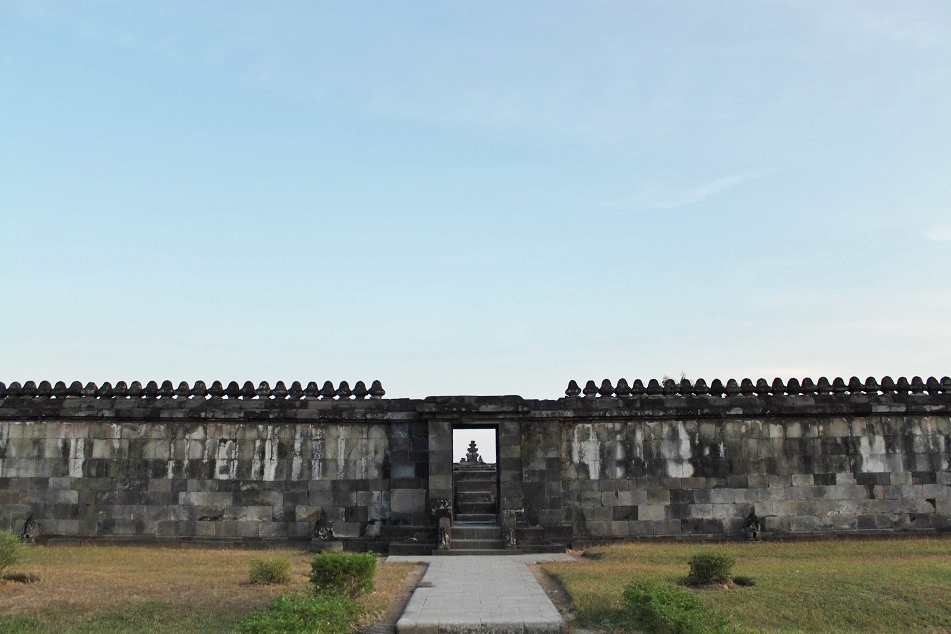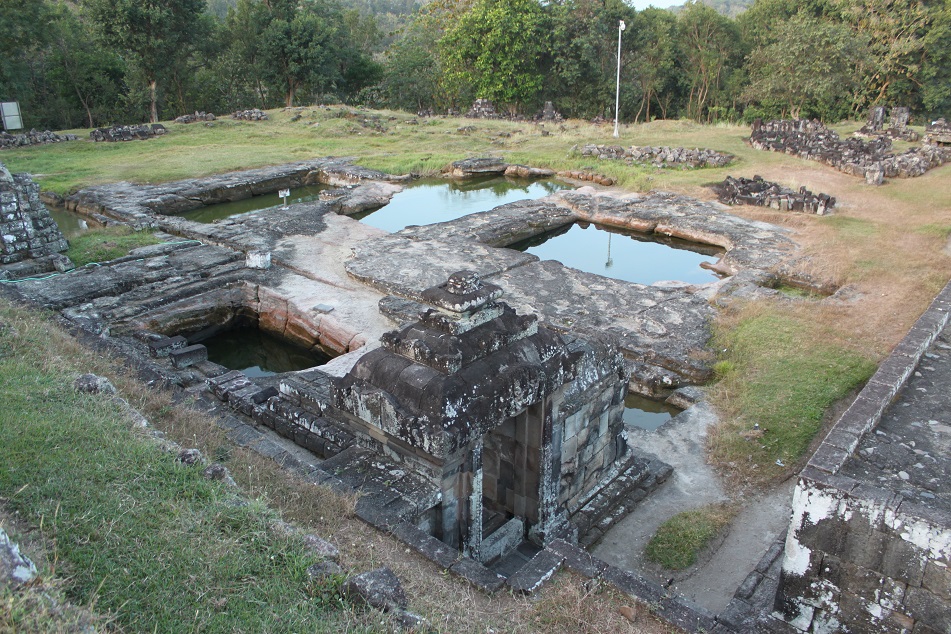Chapter 1, Part 11
Perched on a hill in the Kewu Plain, an unassuming compound of ancient structures made from andesite rocks is a beauty shrouded in mystery. Its roofed gate stood elegantly, in contrast with the austere walls surrounding the vast complex. Unassuming it is compared to the rich embellishments that adorn the Hindu-Buddhist monuments in the temple-studded plain, from Shivagrha to Manjusrigrha, which were constructed more than a thousand years ago.
Ratu Boko, also called Kraton Ratu Boko, is in fact the only surviving non-religious heritage built during the Medang kingdom period in Central Java. Most historians agree that a vihara (Buddhist temple) was first built on the hill. Taking the name Abhayagiri, it was indeed modeled after the other vihara in Anuradhapura by the same name, although the Javanese version was most likely more modest in size compared to its Sri Lankan counterpart. What we see today, however, resembles more like a palace complex than a Buddhist monastery.
A few steps after walking through the roofed entrance way, the crematory comes into sight on the left hand side. Despite its name, no human trace has ever been found within its rectangular niche, suggesting that woods were the only things that had been burned inside. Walking past a vast grass field, dotted with purportedly remnants of a building’s foundation, the four of us – Badai, Bart, James and I – reach the far end of the compound after walking down an ancient staircase through a gate whose lintel probably had collapsed many centuries ago. There, a walled enclosure – called the pendopo – with pear-shaped decorative pieces aligned on top of the andesite stone walls hide a handful of small shrines and chambers inside. Two secret bathing premises, each with its own walls, are visible from the elevated platform inside the pendopo from which one can get a sweeping view of the surrounding forests.
Based on the inscriptions found around the hill it is believed that during the reign of Rakai Pikatan, a local Hindu ruler by the name of Rakai Walaing challenged his authority. The king’s son and crown prince, Rakai Kayuwangi, pushed the recalcitrant patrician to the hills. Not only did Rakai Walaing defend the palace at the hilltop, he also made inscriptions bearing his name and his great grandfather, the king of Halu who, some historians believe, was related to Sanjaya, the king who reestablished Sailendra’s reign in much of Central Java. Hence the theory that Rakai Walaing was trying to usurp the throne of Medang.
During the restoration work, Buddhist and Hindu cultural artifacts were found within the palace compound, including statues of Dhyani Buddhas and Shaivite deities. They suggest either coexistence or syncretism between the two religions, at the time dominant in Central Java. In fact, a theory emerged, suggesting a historical connection between Kraton Ratu Boko and Balaputra, the Buddhist prince who fled to Srivijaya in Sumatra following the return of Hinduism to the royal court of Medang in the ninth century.
The union of Medang and Srivijaya was in fact broken. The former continued to assert Hindu influence in Java, while the latter was about to witness its power greatly challenged by an imminent threat across the Indian ocean in the beginning of the 11th century. An event that would forever change the political landscape in Southeast Asia.
Click here for the full list of stories from the Spice Odyssey series.

















Fascinating history and amazing pictures.
LikeLike
Thank you for your kind comment always, Miriam. Much appreciated!
LikeLiked by 1 person
Ada sumber yang mengatakan bahwa kompleks Ratu Boko dulu merupakan tempat tinggal Roro Jonggrang yang didirikan ayahnya, Raja Baka. Meski akhirnya keraton diserang oleh Pangeran Bandung Bondowoso dari Kerajaan Pengging karena perselisihan Prambanan dan Pengging akibat keserakahan Raja Baka ingin menggabungkan kedua wilayah tersebut. Kisahnya sendiri antara sejarah dan legenda. 🙂
LikeLike
Yes, betul. Jadi Kraton Ratu Boko, Prambanan, dan Sewu semuanya terkait satu sama lain dalam cerita Roro Jonggrang, cerita yang muncul jauh setelah bangunan-bangunan tersebut ditinggalkan dan penduduk setempat tidak mengetahui dengan pasti sejarah dari bangunan-bangunan itu. Akhirnya tercampur lah sejarah dan legenda. Sekarang pun kecenderungan seperti ini masih terus terjadi kan? Banyak orang-orang yang mencapuradukkan fakta dan mitos. 🙂
LikeLiked by 1 person
Beautiful place
Great photos
LikeLike
Merci Stamatiou. Despite its modest size compared to Borobudur or Prambanan, Ratu Boko certainly has its own charm.
LikeLiked by 1 person
The ability of ancient people (throughout the world) to build huge structures of stone blocks is truly astounding. Thanks for the great photos and history!
LikeLike
That never ceases to amaze me either, Marilyn. It’s mind-boggling to visit this kind of ancient site and think of how it was built many many centuries ago, let alone those in places like Egypt, Greece, and the Levant. Really appreciate your kind words. Thanks!
LikeLike
Oh, I just love the close ups of the decorative ornaments. You really are talented because you make me want to go and see everything for myself! Also the photo of the plane above the ruins and the sunset shot are truly great 🙂 I don’t have the time to read about the history (sorry, I know how much effort goes into researching and writing it all down) but the photos I can’t miss! Thank you!
LikeLike
Thank you, Katha. That’s very kind of you to say. The airport is located not too far from the city center, so spotting airplanes flying over those ancient sites is fairly easy. No worries for not having the time to read the post thoroughly, as long as this sparked that wanderlust within you. 🙂
LikeLiked by 1 person
Bama what a capture of the plan over the ruins. As always your photos are superb. In a previous post or comment you spoke of the numbers of photos you take. How do you make the final decision on which make the cut to the article?
LikeLike
Thank you, Sue. Usually for the photos of a place, I choose the ones that most people are familiar with, as well as those that are rarely seen, 20-80 respectively.
LikeLiked by 1 person
Sepertinya waktu paling pas untuk mengunjungi Keraton Ratu Boko ini memang di kala senja hari ya? Terasa banget mistisnya, terutama ketika kita memasuki area pendoponya yang kebetulan waktu itu sudah mulai gelap. Meskipun letaknya memang agak masuk ke dalam, adri jalanan utamanya, tapi aku gak nyangka kalau peninggalan bangunan keraton ini mudah untuk dicapai. Aku pikir bakal mblusuk-mblusuk gitu.
Btw selamat ulang tahun ya Bam, semoga panjang umur dan makin keren ngeblognya 😉
LikeLike
Sepertinya sih iya. Pas aku pertama kali ke Ratu Boko entah gimana aku gak jalan sampe ke pendoponya dan baru tau kalo kompleks Ratu Boko ini cukup luas beberapa lama setelah trip selesai. 😀 Makanya aku cukup puas pas kemarin kita ke sana bisa liat pendopo sama keputrennya, meskipun agak buru-buru dikejar hari yang mulai gelap. Mengunjungi candi yang mblusuk-mblusuk kayaknya seru banget ya, berasa kayak Indiana Jones.
Thank you, Bart. Amiiin. 🙂
LikeLiked by 1 person
Iya betul. Dan kayaknya kita harus bikin trip berburu candi lagi deh Bam. Btw, belum satupun hasil jalan-jalan waktu itu yang aku tulis. Hutanganku masih banyaaak 😀
LikeLike
Hayuk! Pengen deh mengeksplor candi-candi di Sumatra. Gpp Bart, kan at least kamu punya banyak bahan untuk nulis di blog. 🙂
LikeLiked by 1 person
Iya ya, candi-candi Sumatra masih banyak yang kurang dijelajahi.
LikeLike
Muaro Jambi, Muara Takus, Biaro Bahal, dll.
LikeLiked by 1 person
Belum satupun hehehe …
LikeLike
beautiful photos and prose
LikeLike
Thank you for reading and leaving such a kind comment, Stephanie.
LikeLiked by 1 person
I think sometimes these simpler places make for even better photos. One can really focus on small details, as you did with those tremendous up-close pictures of the gate ornamentation, states, etc.
LikeLike
That’s true, Lex, which reminds me of Japanese people who love their elegant simplicity. Sometimes less is more.
LikeLiked by 1 person
the fall of lights on the idol of Vishnu is mesmerizing
LikeLike
And I was there just at the right time to capture the beauty.
LikeLiked by 1 person
Ratu Boko is such a mysterious ancient complex – I wonder what it would have looked like with all the original wooden pavilions intact. And how its stones glowed in the late afternoon light! I’m glad we were there in time to see that, before the skies darkened and the sun set.
LikeLike
I wonder if the layout and architecture of the ruins of Taman Sari bear any similarities with those of Ratu Boko, with the walled bathing compound and all. And that view of the Kewu Plain from the hill above the crematory, truly a view only royalties could afford — which reminds me, in a way, of Sigiriya.
LikeLiked by 1 person
I really enjoy your style of writing; immersive, detailed, and highly informative. I especially liked how you tied in the Sri Lankan counterpart. The history of here seems very rich.
LikeLike
Thanks Darcy! It is indeed my purpose to write this series: to show people the long-lost connections among nations in Southeast and South Asia. Today ordinary Indians rarely hear about Indonesia, or ordinary Indonesians don’t know much about Sri Lanka, etc.
LikeLiked by 1 person
Very cool angle man, keep it up!
LikeLike
I really enjoyed this. It was so cool and you have incredible photos. Adding this to my travel list
LikeLike
Thank you, Nico. Much appreciated and I’m really glad you enjoyed this post.
LikeLike
Bama, you are such a wealth of knowledge! I learn so much from your posts, and your photos tell an intriguing story — the Pendopo and princess baths are particularly compelling. I find the complexes and ruins you visit in Indo to be as fascinating as anything in Greece or Turkey. Thanks for your insight.
LikeLike
Kelly, you’re so kind. What I’ve been doing is basically collecting the knowledge other people have gathered and learned, and share some of it on my blog so we all can learn a thing or two from history. Many ruins here are not quite well-known to people, let alone to foreigners. There are more intriguing ancient temples and ruins in East Java which I have yet to visit, so I’ve been hoping to be able to go see them myself in the near future. Thanks for sharing your thoughts, and it’s always nice to hear from you, Kelly.
LikeLike
Baru tenar akhir-akhir ini ya.. Next, kalo ke Yogya udah masuk daptar….
LikeLike
Hi Vika. Sepertinya ketenaran Ratu Boko dan tempat-tempat lainnya didukung oleh media sosial juga, salah satunya Instagram. Kalau ke Jogja disempatkan ya, apalagi kalau suka dengan sejarah dan candi-candi.
LikeLike
Pingback: Sabang and Hikkaduwa: After the Tsunami | What an Amazing World!